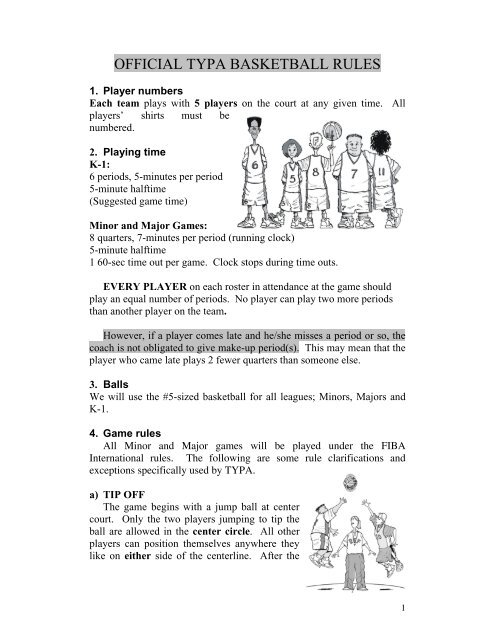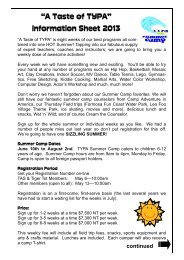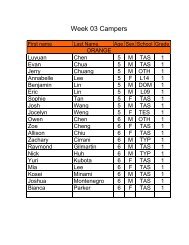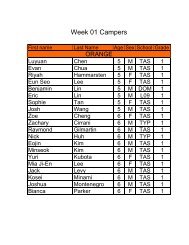You also want an ePaper? Increase the reach of your titles
YUMPU automatically turns print PDFs into web optimized ePapers that Google loves.
<strong>OFFICIAL</strong> <strong>TYPA</strong> <strong>BASKETBALL</strong> <strong>RULES</strong><br />
1. Player numbers<br />
Each team plays with 5 players on the court at any given time. All<br />
players’ shirts must be<br />
numbered.<br />
2. Playing time<br />
K-1:<br />
6 periods, 5-minutes per period<br />
5-minute halftime<br />
(Suggested game time)<br />
Minor and Major Games:<br />
8 quarters, 7-minutes per period (running clock)<br />
5-minute halftime<br />
1 60-sec time out per game. Clock stops during time outs.<br />
EVERY PLAYER on each roster in attendance at the game should<br />
play an equal number of periods. No player can play two more periods<br />
than another player on the team.<br />
However, if a player comes late and he/she misses a period or so, the<br />
coach is not obligated to give make-up period(s). This may mean that the<br />
player who came late plays 2 fewer quarters than someone else.<br />
3. Balls<br />
We will use the #5-sized basketball for all leagues; Minors, Majors and<br />
K-1.<br />
4. Game rules<br />
All Minor and Major games will be played under the FIBA<br />
International rules. The following are some rule clarifications and<br />
exceptions specifically used by <strong>TYPA</strong>.<br />
a) TIP OFF<br />
The game begins with a jump ball at center<br />
court. Only the two players jumping to tip the<br />
ball are allowed in the center circle. All other<br />
players can position themselves anywhere they<br />
like on either side of the centerline. After the<br />
1
initial jump ball, the possession arrows will take over.<br />
The players tipping the jump ball must wait until the referee's throw<br />
reaches the top of its flight and then tip it to another player. They may tip<br />
it more than once, but may not grab the ball.<br />
b) TRAVELING<br />
Taking more than 1 & 1/2 steps while in possession of the ball and not<br />
dribbling is considered traveling and results in the ball being turned over<br />
to the opposing team. Traveling also occurs when a player stops his/her<br />
dribble and then moves or changes his/her pivot foot.<br />
YES<br />
NO<br />
c) THREE SECOND RULE<br />
Applies only to Major Boys and Girls. This rule has been slightly<br />
altered to become a FIVE SECOND RULE. No player from the<br />
offensive team may have any part of his/her feet continuously on or<br />
inside the rectangular area directly between the free throw line and the<br />
end line for more than five seconds. This area is<br />
often referred to as "the key."<br />
d) STEALS<br />
There will be no stealing in K-1, Minor Boys and Girls. A defender<br />
may not steal the ball from a dribbling player or from a stationary<br />
offensive player. An interception of a pass is ok. Any steal or attempt<br />
at a steal will be called a foul.<br />
There will also be no double-teaming or swarming of the player<br />
with the ball. Only one defensive player can be defending the person<br />
with the ball.<br />
2
e) FOULS<br />
Illegal contact between two players is called a foul. There are<br />
several kinds of fouls. Fouls can be offensive or defensive. Fouls on the<br />
defense are more common. Any time a defensive player illegally contacts<br />
an offensive player a "foul" will be called.<br />
Offensive fouls are called "charging". This foul occurs when an<br />
offensive player, (usually the player with the ball), runs into a defensive<br />
player who has established proper defensive position. The defensive<br />
player must not be moving and may not stick out his/her hands, legs or<br />
hips. Please refer to the FIBA rules for further definition and<br />
clarification.<br />
In an attempt to speed up the games and cut down on fouls, we will be<br />
using the 1-point a foul system; one point will be awarded to the team<br />
who's player was fouled and the ball given out of bounds to that team.<br />
No points for offensive fouls.<br />
If a player was fouled while taking a shot, he/she will be given 1 point<br />
and possession of the ball. If a player is fouled while taking a 3 point<br />
shot, he/she will be given two points and the ball. If the basket goes in,<br />
the team receives 3 points (2 plus 1) or 4 points (3 plus 1) and the fouling<br />
team takes the ball out of bounds.<br />
Since we are using the 1-point a foul rule, we will therefore not shoot<br />
free throws.<br />
UNSPORTSMANLIKE FOULS which endanger another player will be<br />
penalized by 2 points + the ball out of bounds. The player committing<br />
the unsportsmanlike foul may also be ejected from the game.<br />
A team can refuse the "free points" if it desires.<br />
3
f) 10 - SECOND BACKCOURT VIOLATION<br />
The half court line is the line that divides the court in half. When<br />
moving from the defensive end of the court to the offensive end, your<br />
team has ten seconds to get the ball across the half court line.<br />
FULL COURT PRESSING will not be allowed. There is also no Half<br />
Court violation.<br />
Major Boys must retreat to their defensive half court. Once the<br />
offensive players have crossed the half court line they may begin<br />
defending them.<br />
Major Girls, Minor Boys and Minor Girls must retreat to inside their<br />
defensive 3-point line.<br />
g) FIVE - SECOND INBOUND<br />
VIOLATION<br />
Players have five seconds to pass the<br />
ball inbound to a teammate after taking<br />
possession of it from the referee.<br />
h) THREE – POINT SHOT<br />
Three points will be awarded to any player whose last step before<br />
shooting was ON or BEHIND the three-point line.<br />
i) CONSECUTIVE BASKET RULE<br />
A player cannot score 3 baskets in a row. The end of quarter will<br />
restart the consecutive basket rule (i.e. A player can score the last 2<br />
baskets of the quarter and the first 2 baskets of the next quarter).<br />
j) SUBSTITUTIONS<br />
Substitutions are allowed only after the end of a quarter or when a<br />
player is injured.<br />
k) UNIFORMS<br />
Players MUST wear<br />
their uniforms to play in<br />
games. Uniforms must<br />
also be tucked in. Players<br />
waiting to play MUST sit<br />
on the bench provided.<br />
4
Hats, jewelry, watches and other such items will not be allowed.<br />
Shoelaces must be securely tied. The referee will stop the game and<br />
require players to immediately tie their shoes.<br />
l) TIME OUTS<br />
Each team will be allowed 1 60-sec timeout per game. The clock<br />
will stop for time outs.<br />
m) MERCY RULE<br />
WHENEVER one team gets ahead by 20 points or more, the<br />
scoreboard will stop showing the score.<br />
n) COACHES BOX<br />
Coaches and players not currently in the game will not be allowed on<br />
the court and will not be allowed to cross the half court mark while on the<br />
sidelines. Coaches and players cannot stand in front of the scoring<br />
table.<br />
o) DISQUALIFICATION<br />
Any player or coach may be disqualified or<br />
kicked out of a game for several reasons.<br />
These include fighting, arguing with the<br />
referee, or receiving two technical fouls.<br />
THE REFEREE has the last say during all<br />
games. Protests against a referee’s call will<br />
not be accepted.<br />
The <strong>TYPA</strong> Sports Director has the right to add, change or delete any<br />
rule during the season.<br />
(*These rules and photos have been taken from the FIBA mini basketball<br />
rules 2005)<br />
5
















